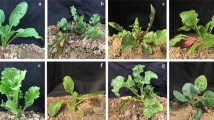Abstract
The tree peony (Paeonia suffruticosa Andr.) is a valuable ornamental plant. American and French cultivars have desirable flower colors, while, Japanese cultivars have larger flowers with better presentation. We hybridized an American tree peony cultivar ‘High Noon (HN)’ (the seed parent) with 57 different Japanese cultivars (pollen parents) to investigate cross compatibility, with the ultimate goal of obtaining improved hybrids. Of the 1,927 crosses performed, 135 (38 cross combinations) yielded a total of 181 seeds (86 mature) and 22 seedlings. Five of the hybrids have already flowered and exhibited their parent character with large yellow flowers. To investigate the causes of cross incompatibility, we examined pollen tube growth in a cross between ‘HN’ and a Japanese cultivar. The result indicated that there are three most important causes of incompatibility, namely, abnormal pollen tube growth, the failure of fertilized ovules, and poor seed germination. Although cross compatibility in each combination was low, crosses between ‘HN’ and Japanese cultivars might be successful with the right paternal plants. In this study, 13 Japanese cultivars had higher cross compatibility with ‘HN’ than the others. Our results will enhance tree peony breeding and guide the selection of parents for hybridization.



Similar content being viewed by others
References
Ali M, Fujieda K (1990) Cross compatibility between eggplant (Solanum melongena) and wild relatives. J Jpn Soc Hort Sci 58:977–984
Han XY, Wand LS, Liu ZA, Jan DR, Shu QY (2008) Characterization of sequence-related amplified polymorphism markers analysis of tree peony bud sports. Sci Hort 115:261–267
Hao Q, Liu ZA, Shu QY, Zhang RE, Jan DR, Wand LS (2008a) Studies on Paeonia cultivars and hybrids identification based on SRAP analysis. Hereditas 145:38–47
Hao Q, Liu ZA, Shu QY, Wand LS, Chen FF (2008b) Identification of intersectional hybrid between section Moutan and section Paeonia in China for the first time (in Chinese with English summary). Acta Horti Sinica 35:853–858
Hashida R (1990) Encyclopedia of tree and herbaceous peony (in Japanese). Koudansha, Tokyo, pp 170–182
He GM (2006) Studies on distant cross-breeding and embryo in vitro culture and somatic embryogenesis in tree peonies (in Chinese with English summary). Ph. D. thesis, Beijing Forestry University, Beijing, pp 27
He GM, Cheng FY (2006) Morphological observation of sexual reproduction abortion in ‘High Noon’ tree peony (in Chinese with English summary). Acta Horti Sinica 33:660–663
Hosoki T, Hamada M, Kando T, Moriwaki R, Inaba K (1991) Comparative study of anthocyanins in tree peony flowers. J Jpn Sco Hort Sci 60:395–403
Jane FW (1999) Peonies in the new world. In: Peonies-the imperial flower. Weidenfeld & Nicolson illustrated. London, pp 138–139
Kessenich G, APS Nomenclature Committee (1976) A. P. Saunders hybrid peonies (Lutea hybrid tree peonies). In: Peonies: the history of the peonies and their originations. American Horticultural Society, Washington, pp 146–152
Li JJ (1998) Studies on the origin of Chinese mudan (tree peony) (in Chinese with English summary). J Beijing For Univ 20:22–26
Li G, Quiros CF (2001) Sequence-related amplified polymorphism (SRAP) a new marker system based on a simple PCR reaction: its application to mapping and gene tagging in Brassica. Theor Appl Genet 103:455–461
Li JJ, Zhang XF, Zhao XQ (2011) Tree peony of China (in Chinese). Encyclopedia of China Publishing House, Beijing, pp 10–11, 278–299
Liu ZA (2003) Study on the forcing and retardation culture of tree peony (in Japanese with English summary). Ph. D. thesis, Shimane University, Matue, pp 1–6
Marta AE, Camadro EL, Az-Ricci JC, Castagnaro AP (2004) Breeding barriers between the cultivated strawberry, Fragaria × ananassa, and related wild germplasm. Euphytica 136:139–150
Martin FW (1959) Staining and observing pollen tubes in the style by means of fluorescence. Stain Technol 34:125–128
McGuire RG (1992) Reporting of objective color measurements. Hort Sci 27:1254–1255
Okamoto A, Suto K (2004) Cross incompatibility between Rhododendron sect. Tsutsusi species and Rhododendron japonicum (A. Gray) J. V. Suringar f. flavum Nakai. J Jpn Soc Hort Sci 73:453–459
Pimienta E, Polito VS, Kester DE (1983) Pollen tube growth in cross- and self pollinated ‘Nonpareil’ almond. J Am Soc Hort Sci 108:643–647
Wister JC (1928) The mountain tree peony. In: Boyd J (ed) Peonies. American Horticultural Society, Washington, pp 219–244
Wister JC, Wolfe HE (1962) The tree peonies. In: Wister JC (ed) The peonies. American Horticultural Society, Washington, DC, pp 146–214
Zhang JJ, Shu QY, Liu ZA, Ren HX, Wang LS, De Keyser E (2012) Two EST-derived marker systems for cultivar identification in tree peony. Plant Cell Rep 31:299–310
Zhou ZQ, Pan KY, Hong DY (2003) Advances in studies on relationships among wild tree peony species and the origin of cultivated tree peonies (in Chinese with English summary). Acta Hort Sinica 30:751–757
Author information
Authors and Affiliations
Corresponding author
Rights and permissions
About this article
Cite this article
Hao, Q., Aoki, N., Katayama, J. et al. Crossability of American tree peony ‘High Noon’ as seed parent with Japanese cultivars to breed superior cultivars. Euphytica 191, 35–44 (2013). https://doi.org/10.1007/s10681-012-0853-3
Received:
Accepted:
Published:
Issue Date:
DOI: https://doi.org/10.1007/s10681-012-0853-3




